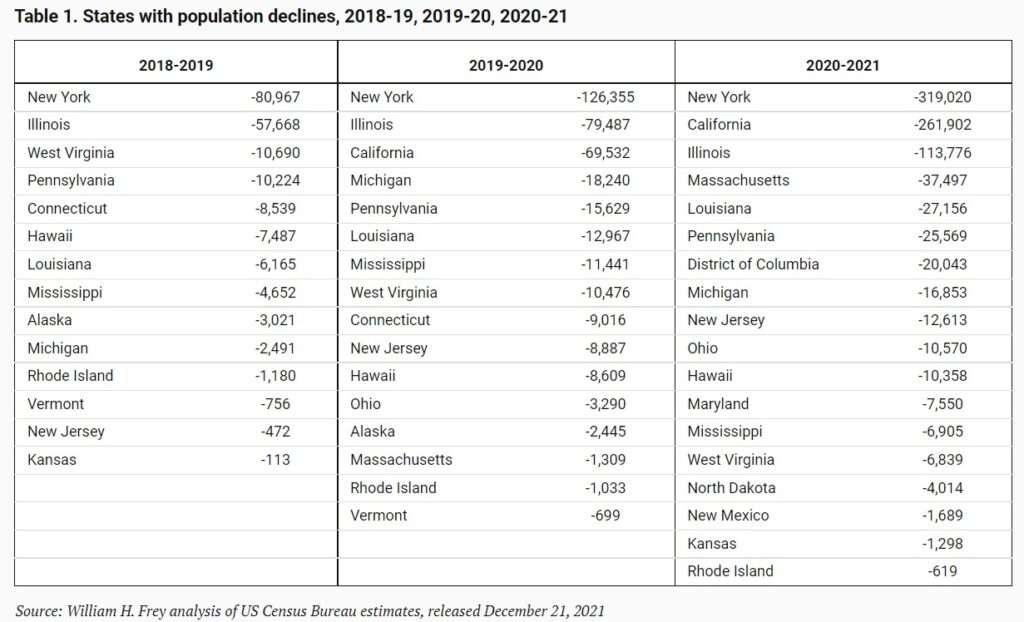The COVID-19 pandemic began in the year 2000. Americans fled California and New York for safety and better health.
Census Bureau data shows that 18 states, plus Washington, D.C., lost population in the period between July 2020, 2021, and now. The losses suffered by many states are small in comparison to those of New York City and California. During those twelve months, the two states had lost 319,00 and 260,000 inhabitants, respectively. Illinois finished third with a loss of 113,000, after having suffered a population collapse for many years.
When viewed in terms of the percentage of their total population, Washington, D.C. suffered the worst. In just twelve months, it lost more that 3.4 per cent of its preandemic population.
On the opposite end, Texas saw an increase of 310,000 people during the same time, with significant migration from Arizona (918,000), Florida (2211,000), and North Carolina (93,000).
Overall, the number of people who moved in the year following the pandemic was lower than that for a normal year. A different set of Census Bureau data was released a few months back. It showed that moves fell to the lowest level in at least 70 year in the twelve months from April 2020 to March 2021. This only throws some of the figures in sharper relief. Even though there was a decrease in overall migration, New York and California experienced significant increases in departures during the period July 2020-2021.

The pandemic seemed to have intensified migration trends already in progress, as it had done elsewhere. California and New York suffered significantly greater losses than the previous two years in 2020-21, just as it was for many states with recent population loss,” says William H. Frey (a Brookings Institution senior fellow).
New York’s population has been declining for many years. California’s population fell nearly flat in the last decade after decades of rapid growth. California’s congressional delegation is likely to shrink due to the fact that the rest the nation grew quicker than it.
Many factors can influence a person’s decision to relocate from one area to the next. These decisions are more dependent on individual factors than economic or political issues. It is important to not assign too much significance to figures relating migration. Some partisans will try to make a point by saying that Americans are moving to the red state from blue. This may even be true in some cases. However, it overlooks the fact that personal decision-making is based upon many factors, some of them not politically motivated.
States are not monoliths—someone moving to the booming West Texas city of Midland is probably doing so for a different reason than someone moving to also-booming Austin—and a successful state is capable of attracting more than one type of person. In fact, states that are successful grow despite their political stereotypes and not because of them.
These important caveats aside, it is difficult to examine the Census Bureau’s new data and not make some generalizations about why California, New York, and to a lesser extent D.C., were so remarkable outliers in the last year.
Pandemic policy is a common theme. New York’s capacity restrictions were not lifted until May 2012, even though similar laws had been repealed in many other countries. Los Angeles economic restrictions often had little meaning and were especially harsh for small businesses. School closures, where were concentrated in big cities and blue states—places that have, not surprisingly, now seen a corresponding drop in enrollments—made life more difficult for parents and children. People say that they are moving because of financial pressure. Pandemic-era policies were ripe to create new financial problems for large swathes of Americans.
However, I believe that the Census data also shows frustrations with school closings and pandemic rules. Wendell Cox of a St. Louis-based consulting company, who is an expert in population and policy, points out that D.C. has lost around 3.3 percent of its residents after the previous decade of significant annual population increases. Then, he looks at the states gaining population—and not just the biggest ones.
“West Virginia is within the reach of remote workers who spend only a few hours per month on-site. The state saw its domestic migration net total IncreaseCox reports that the average for its past decade was minus 4,600, which has dropped to 2,300.” A New GeographyA blog on urban policy and demographics. “Delaware was similarly near to Washington as Philadelphia and saw its net domestic migration increase rise to 12,000 from the previous decade’s average of + 5,000.
West Virginia and Delaware share some other features with the big population-gaining states like Texas, Florida, and Arizona—namely, low taxes and relatively cheap land (with some exceptions, of course).
Remote work, or part-time remote working, is here to stay. States like West Virginia, Delaware, and others stand to benefit from the East Coast’s post-pandemic cleanup. The geography of many states close together means that there will be more competition. People may choose to live in their own suburbs, and avoid the high costs of living, high taxes, and long commutes to work if they only need to visit the office one week.
The majority of people will continue to live here. Even though Washington saw a dramatic drop in its population over the past year, it still has 96 percent. New York City is still the most important economic hub in the world. California has nearly unlimited natural resources.
However, the fact that so many Americans moved in the pandemic period should be a warning to policy-makers about the reality of what is happening at the margins. There is competition among the states, so the end of the pandemic restrictions will not stop these trends.
Some states will not like the places workers live in a world that empowers them to choose where and when they want to.

